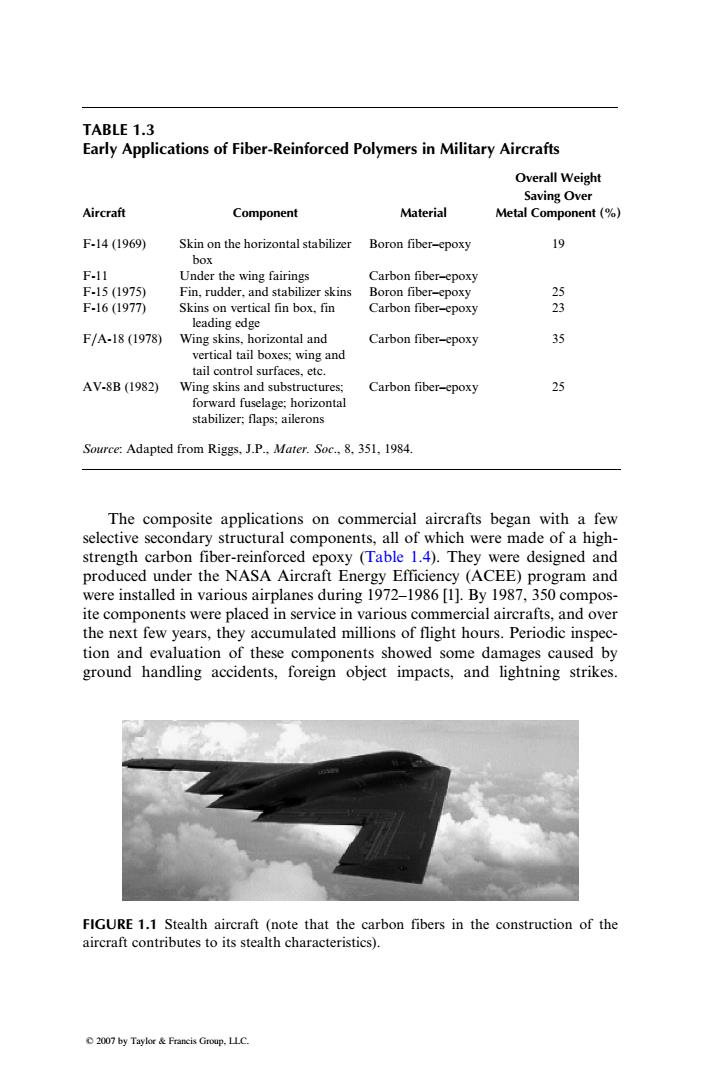正在加载图片...

TABLE 1.3 Early Applications of Fiber-Reinforced Polymers in Military Aircrafts Overall Weight Saving Over Aircraft Component Material Metal Component(%) F.14(1969) Skin on the horizontal stabilizer Boron fiber-epoxy 19 box F.11 Under the wing fairings Carbon fiber-epoxy F.15(1975) Fin,rudder,and stabilizer skins Boron fiber-epoxy 25 F.16(1977) Skins on vertical fin box.fin Carbon fiber-epoxy 2 leading edge F/A-18(1978) Wing skins,horizontal and Carbon fiber-epoxy 35 vertical tail boxes;wing and tail control surfaces,etc. AV-8B(1982) Wing skins and substructures; Carbon fiber-epoxy 25 forward fuselage;horizontal stabilizer;flaps;ailerons Source:Adapted from Riggs,J.P..Mater.Soc.,8.351,1984. The composite applications on commercial aircrafts began with a few selective secondary structural components,all of which were made of a high- strength carbon fiber-reinforced epoxy (Table 1.4).They were designed and produced under the NASA Aircraft Energy Efficiency (ACEE)program and were installed in various airplanes during 1972-1986 [1].By 1987,350 compos- ite components were placed in service in various commercial aircrafts,and over the next few years,they accumulated millions of flight hours.Periodic inspec- tion and evaluation of these components showed some damages caused by ground handling accidents,foreign object impacts,and lightning strikes. FIGURE 1.1 Stealth aircraft (note that the carbon fibers in the construction of the aircraft contributes to its stealth characteristics). 2007 by Taylor Francis Group.LLC.The composite applications on commercial aircrafts began with a few selective secondary structural components, all of which were made of a highstrength carbon fiber-reinforced epoxy (Table 1.4). They were designed and produced under the NASA Aircraft Energy Efficiency (ACEE) program and were installed in various airplanes during 1972–1986 [1]. By 1987, 350 composite components were placed in service in various commercial aircrafts, and over the next few years, they accumulated millions of flight hours. Periodic inspection and evaluation of these components showed some damages caused by ground handling accidents, foreign object impacts, and lightning strikes. TABLE 1.3 Early Applications of Fiber-Reinforced Polymers in Military Aircrafts Aircraft Component Material Overall Weight Saving Over Metal Component (%) F-14 (1969) Skin on the horizontal stabilizer box Boron fiber–epoxy 19 F-11 Under the wing fairings Carbon fiber–epoxy F-15 (1975) Fin, rudder, and stabilizer skins Boron fiber–epoxy 25 F-16 (1977) Skins on vertical fin box, fin leading edge Carbon fiber–epoxy 23 F=A-18 (1978) Wing skins, horizontal and vertical tail boxes; wing and tail control surfaces, etc. Carbon fiber–epoxy 35 AV-8B (1982) Wing skins and substructures; forward fuselage; horizontal stabilizer; flaps; ailerons Carbon fiber–epoxy 25 Source: Adapted from Riggs, J.P., Mater. Soc., 8, 351, 1984. FIGURE 1.1 Stealth aircraft (note that the carbon fibers in the construction of the aircraft contributes to its stealth characteristics). 2007 by Taylor & Francis Group, LLC